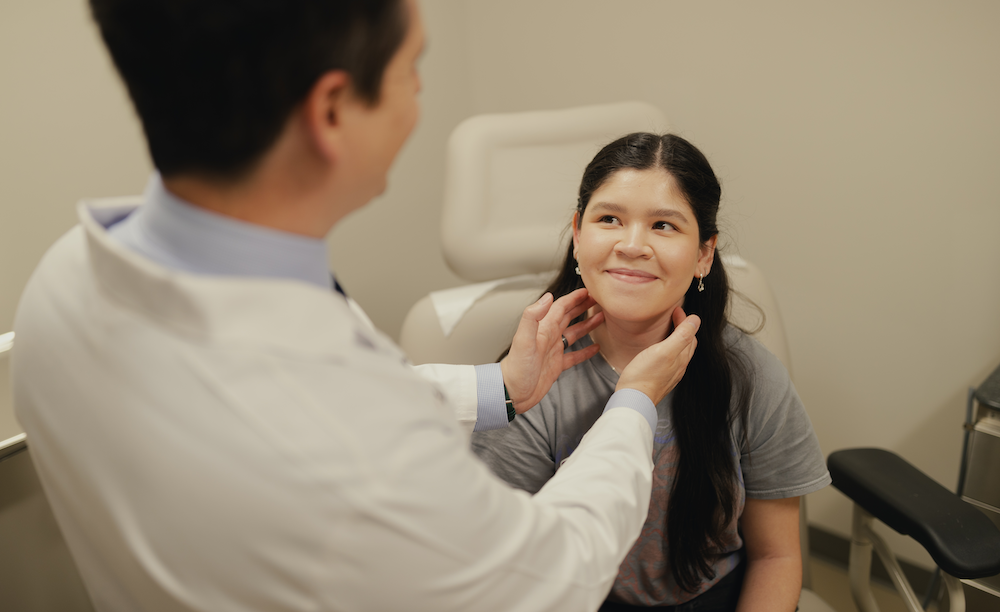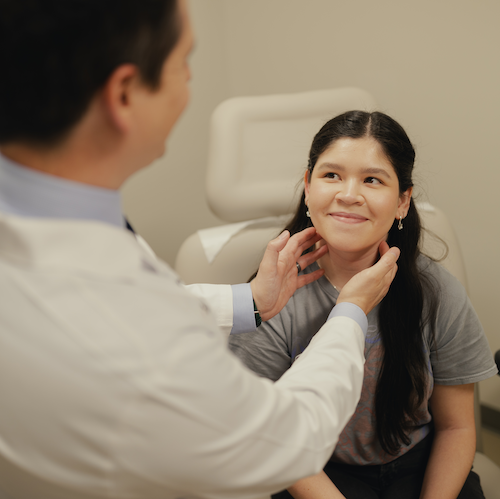

Radioactive Iodine (RAI) Therapy
What is radioactive iodine therapy?
RAI uses a radioactive medication Iodine-131 (or I-131) to treat diseased cells in the thyroid. It is used for some types of thyroid cancers. It is also used to treat Graves’ disease, a condition that causes hyperthyroidism.
Why choose us for your radioactive iodine therapy
As an academic health center, UT Health San Antonio performs a large volume of RAI treatments. Our nuclear medicine doctors are highly experienced in this procedure.
What to expect with radioactive iodine therapy
When undergoing RAI therapy, you swallow a capsule containing radioactive iodine. The procedure itself takes about 15-30 minutes.
RAI therapy for hyperthyroidism (or Graves’ disease) is an outpatient procedure, so you go home right afterwards. RAI therapy for thyroid cancer requires a higher dose of radioactive iodine. You may need to stay in the hospital following treatment.
After the procedure, your body will emit radiation. You will need to isolate yourself from others to prevent exposing them to radiation, especially children and anyone who is pregnant. You may be admitted to a special isolation room in the hospital for the first few days. When you go home, you may need to keep a distance from others for a specified period of time. Check with your treating nuclear medicine physician on how long you should limit exposure based on your individual dosage.
Frequently asked questions about radioactive iodine therapy
How does radioactive iodine therapy work?
The thyroid produces hormones that affect body functions such as metabolism and temperature. Certain types of thyroid cells (follicular and papillary) absorb iodine from the food you eat to function.
During RAI therapy, radioactive iodine enters the body, and the thyroid gland collects it. The radioactive iodine gives off radioactive particles that destroy thyroid cells and tissue. It treats any leftover thyroid tissue that stays after surgery, along with cancer cells that may have spread to other parts of the body or lymph nodes.
What are the advantages of RAI therapy over other treatment options?
Because iodine naturally collects in the thyroid cells, there is little effect on the rest of the body. RAI can also destroy microscopic cells that would be impossible to remove otherwise.
How do I prepare for RAI therapy?
You will meet with your nuclear medicine physician ahead of time to review how to prepare for RAI therapy.
Leading up to your procedure, you may need:
- Blood tests: Blood tests check your thyroid hormone levels to ensure they are high enough for therapy to be effective.
- Low-iodine diet: Your doctor may recommend that you limit foods containing dairy products, eggs, iodized salt, red dye #3, seafood and soy. We will give you instructions on the exact amount of time you need to avoid these foods and additives. This is to help get your thyroid ready for the radioactive iodine.
- Thyroid-stimulating hormone (TSH): If your TSH levels are low, you may be given injections to ensure your thyroid will take up enough radioactive iodine during therapy.
The day of the procedure, you may need:
- Blood tests
- Pregnancy test
- Preventative nausea or vomiting medication
Your blood needs to have a high TSH level for the treatment to be the most effective. Your doctor may ask you to stop taking thyroid hormone pills for weeks leading up to your procedure. This causes temporary hypothyroidism, where the pituitary gland produces more TSH.
Alternatively, your doctor may recommend a few consecutive shots (injections) of Thyrogen®, a drug that affects TSH levels.
What are the risks and side effects of RAI?
There are multiple possible side effects of RAI, including:
- Dry mouth
- Issues with tear production (too much or too little)
- Nausea or vomiting
- Neck swelling or tenderness
- Salivary gland swelling or tenderness
Get cancer care
Call 210-450-9731 to request an appointment with one of our experts to find out if you may be eligible for RAI therapy.

 Close
Close
